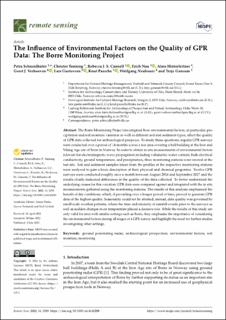| dc.contributor.author | Schneidhofer, Petra | |
| dc.contributor.author | Tonning, Christer | |
| dc.contributor.author | Cannell, Rebecca J S | |
| dc.contributor.author | Nau, Erich | |
| dc.contributor.author | Hinterleitner, Alois | |
| dc.contributor.author | Verhoeven, Geert | |
| dc.contributor.author | Gustavsen, Lars | |
| dc.contributor.author | Paasche, Knut | |
| dc.contributor.author | Neubauer, Wolfgang | |
| dc.contributor.author | Gansum, Terje | |
| dc.date.accessioned | 2023-03-16T13:31:37Z | |
| dc.date.available | 2023-03-16T13:31:37Z | |
| dc.date.created | 2022-08-02T18:46:57Z | |
| dc.date.issued | 2022 | |
| dc.identifier.issn | 2072-4292 | |
| dc.identifier.uri | https://hdl.handle.net/11250/3058833 | |
| dc.description.abstract | The Borre Monitoring Project investigated how environmental factors, in particular, precipitation and soil moisture variation as well as different soil and sediment types, affect the quality of GPR data collected for archaeological purposes. To study these questions, regular GPR surveys were conducted over a period of 14 months across a test area covering a hall building at the Iron and Viking Age site of Borre in Norway. In order to obtain in situ measurements of environmental factors relevant for electromagnetic wave propagation including volumetric water content, bulk electrical conductivity, ground temperature, and precipitation, three monitoring stations were erected at the test site. Soil and sediment samples taken from the profiles at the respective monitoring stations were analysed to gain a basic description of their physical and chemical properties. Twelve GPR surveys were conducted roughly once a month between August 2016 and September 2017 and the results clearly indicated differences in the quality of the data collected. To better understand the underlying causes for this variation, GPR data were compared against and integrated with the in situ measurements gathered using the monitoring stations. The results of this analysis emphasised the benefit of dry conditions, which, if prevailing over a longer period of time, proved to generate GPR data of the highest quality. Seasonality could not be attested; instead, data quality was governed by small-scale weather patterns, where the time and intensity of rainfall events prior to the surveys as well as sudden changes in air temperature played a decisive role. While the results of this study are only valid for sites with similar settings such as Borre, they emphasise the importance of considering the environmental factors during all stages of a GPR survey and highlight the need for further studies investigating other settings. | en_US |
| dc.description.abstract | The Influence of Environmental Factors on the Quality of GPR Data: The Borre Monitoring Project | en_US |
| dc.language.iso | eng | en_US |
| dc.relation.uri | https://www.mdpi.com/2072-4292/14/14/3289 | |
| dc.subject | Arkeologisk geofysikk | en_US |
| dc.subject | Archaeological geophysics | en_US |
| dc.title | The Influence of Environmental Factors on the Quality of GPR Data: The Borre Monitoring Project | en_US |
| dc.title.alternative | The Influence of Environmental Factors on the Quality of GPR Data: The Borre Monitoring Project | en_US |
| dc.type | Peer reviewed | en_US |
| dc.type | Journal article | en_US |
| dc.description.version | publishedVersion | en_US |
| dc.subject.nsi | VDP::Annen arkeologi: 099 | en_US |
| dc.subject.nsi | VDP::Other subjects within archaeology: 099 | en_US |
| dc.source.volume | 14 | en_US |
| dc.source.journal | Remote Sensing | en_US |
| dc.source.issue | 14 | en_US |
| dc.identifier.doi | 10.3390/rs14143289 | |
| dc.identifier.cristin | 2040760 | |
| cristin.ispublished | true | |
| cristin.fulltext | original | |
| cristin.qualitycode | 1 | |
